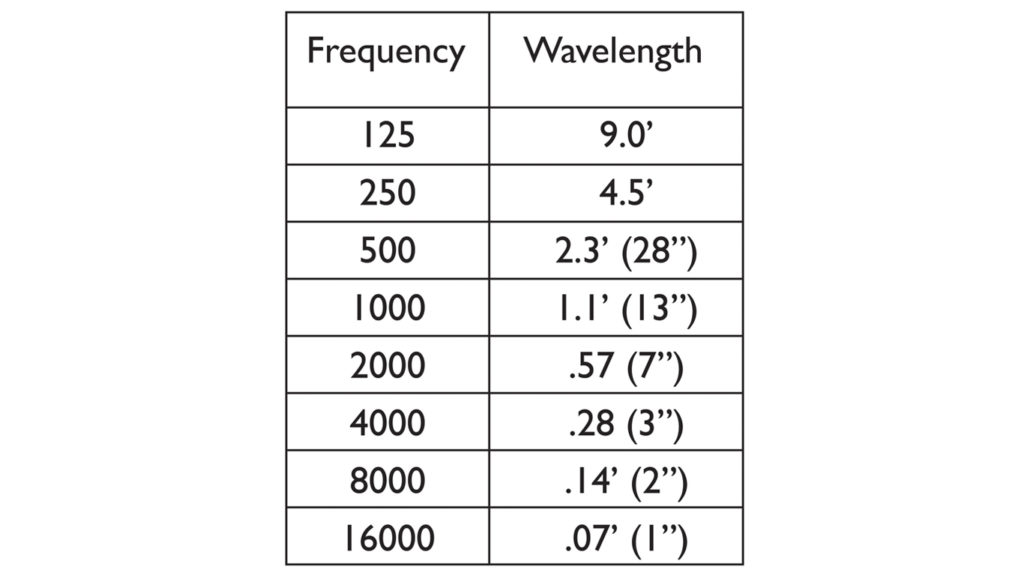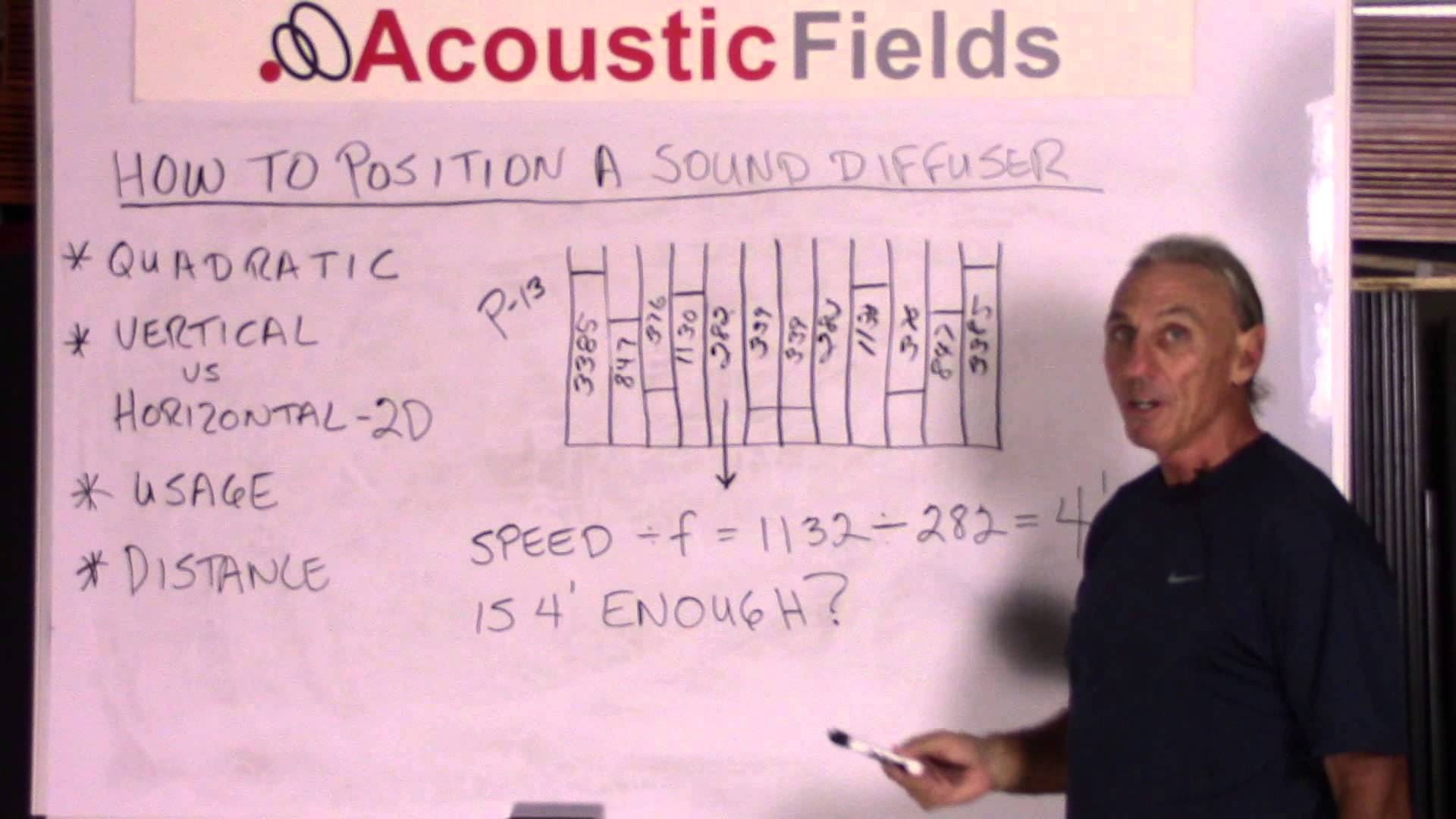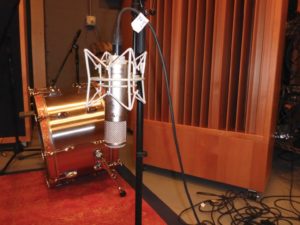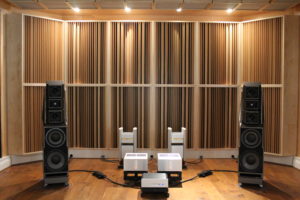This blog has been updated since its original posting to reflect changes and new information in regards to sound diffuser placement in your room, updated on 11/12/19/
Quadratic Diffusion
Today we’re going to talk about ideal sound diffuser placement and, more specifically, how and where to position your sound diffuser for your particular room usage. If you’ve been following my videos then you know that we prefer quadratic diffusion here at Acoustic Fields for two reasons:
1. It’s predictable with a measured frequency response.
2. It’s with work in two of the three soundfields.
You can actually select the frequency response of the diffuser that you want to use for that particular room position and that’s what we’re going to talk about a little bit today. You can position the diffuser in a vertical or horizontal physical position to create one or two dimensions of diffusion. Where to use vertical or horizontal diffusion within your room depends on the distances between room boundary surfaces and room usage.
Sound Diffuser Placement Within Your Room
With our quadratic diffuser, we have both vertical and horizontal diffusion capabilities. If the diffuser is vertically placed we know that it diffused sound is spread out in a horizontal domain. If it’s horizontally placed, we know it diffuses vertically which spreads the sound out in a vertical 180-degree fan-like array. We have two out of three possible dimensions of sound within our room. It’s a pretty powerful tool if you think about it. What are we going to do with diffusers in our room and distances? What diffuser goes where? Where do you put it? On what wall? How much do you use?
Let’s Try to Answer Some of Those Questions.
We always have to get back to usage. What is the usage of the room? Because every room’s usage determines the positions of the sound diffusers, what frequency response we will use and how much surface area to cover with diffusion. Control rooms are different than critical listening rooms. Critical listening rooms are different than voice and live rooms and all of those rooms are vastly different than home theater. The first thing we have to do is look at usage. What is the usage of the room? That’ll tell us what kind of diffusers to use and where to put them. We’ll get to that a little bit later but let’s just get to some basic rules about diffusion and in terms of distances and I think it’ll help us understand.
The image above shows a prime 13 diffuser (this is actually one of our DIY plan links). The diffuser shown is based upon prime number 13. If it is a prime 13, then it has twelve wells or troughs. A diffuser always has one well less than the prime number indicates. Each well or trough depth corresponds to a frequency at quarter wavelength depth. Every well or trough width corresponds to a half wavelength frequency.
To see all of our DIY Plan Kits Click Here
This is the frequency we want to look at in order to determine the distance, how far away from our listening position it should be. So this is the key factor here in diffusers. What’s the lowest frequency the diffuser diffuses?
So Does One Diffuser Fit All Situations?
The short answer is no. You have to look at the distances from the wall surface where the diffuser is going to go to the seated position. This is all critical to getting the maximum performance out of your diffuser. You must have enough distance for the lowest octave to fully form at the listening or monitoring position to maximize the frequency response of the diffuser and the surface area it covers.
Let’s use 250 Hz. as our example. A 250 cycle ray of energy is almost 5′ long. If we divide the speed of sound by the frequency 250, we ~ 4 feet. If the well or trough depth is at a quarter wavelength then we need 12″ of well depth at 250 Hz. With a four feet long ray of energy, we need at least 4′ of distance from the diffuser to the listening position to hear the fill 250 cycles of energy. You actually need twice that distance. You need twice the distance so you achieve two full 4′ oscillations.

Frequency Vs. Wavelength 125Hz – 16K Hz
There are applications for all the primes but we have to keep the distance from the lowest frequency in a diffuser to our seated position in order to maximize the diffusion of that waveform. Diffusers are distant and frequency response-dependent. They are also very user-dependent. Each room usage requires either one or two dimension diffusion. The surface area of treatment and usage will dictate the prescription. As a general rule, we try to get as much diffusion, as many sequences, as many frequencies in our diffusers as we can. So we try to get the highest prime that we can. We want to make sure that we have those distances to work with.
Different Sound Diffuser Placement For Different Room Usage
If it’s a control room we’re probably going to want an absorptive front end and diffusion on the rear wall to prevent the slapback from the rear wall. We do not want any time-delayed reflections in our mixes. For home theaters, we want the front, rear wall, and ceiling. Theater application depends on the number of channels. For listening rooms, diffusion is good on the front and the rear walls because we’re trying to create a natural sound stage and environment. We would use vertical diffusion on the front and rear walls in a listening room.
- Quadratic Diffuser Around Microphone
- Quadratic Diffuser Placement on Front Wall
In Summary
So I hope that helps you understand a little bit more about the positioning of diffusers for your particular room requirements. If you have a chance I would suggest you watch this sister video I made as part of understanding the diffusion process.
Thanks,
Dennis











Hello
today I saw a studio having RPG in the front wall in middle of the speakers, isn’t a mistake?
I always had the idea that should be absorbed in that area in order to get just clean sound from the speakers and noting else.
I would love to hear some opinions
Hi Gigi,
Their are no absolutes in acoustical treatment for the middle and high frequencies. Some prefer a diffused front end and some like absorption. It depends on the music and style of the engineer.
Dennis
Hello
how will you place a sound diffuser in multi purpose auditorium.Like how can disperse around the hall with combination of refelectors and sound absorbents
S, Diffusion is a technology to make small rooms sound larger. Absorption is the technology you need for an auditorium.
S, Diffusion is a technology that makes small rooms sound larger. You need absorption for an auditorium.
can you use the QD diffuser on front wall and or side wall with success. I have an older model and can stack it on top of a bass absorber in between the speakers. not sure i need it on the rear wall as its further from my listening position and it will have a plant shelf back there as well as bass traps in the corners so the plants will be in between the traps on rear wall spanning entire wall. So my question is I normally see QD diffuser on rear wall. want to make sure they are just as good on front wall before I place them or buy something else for this.
N, I am going to assume you are speaking about two channel listening. You do not state usage in your question. Diffusion on the front and rear walls will work well for that usage.